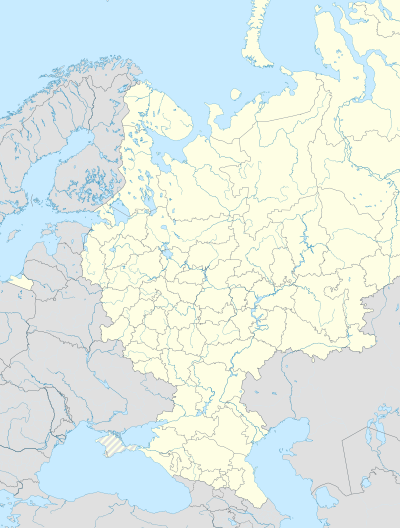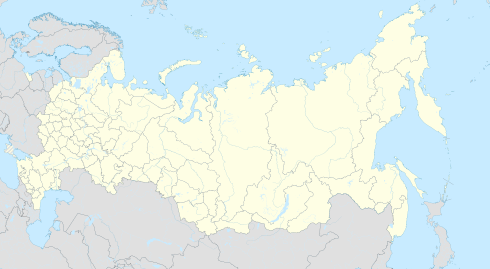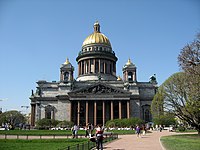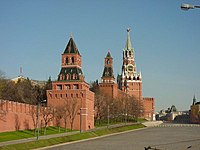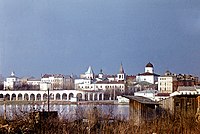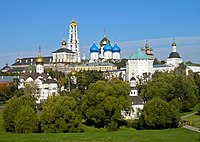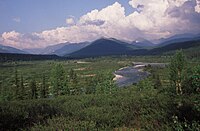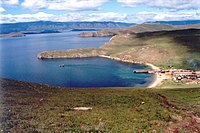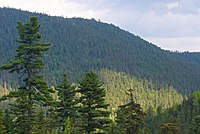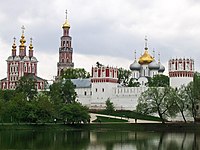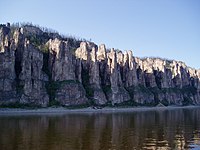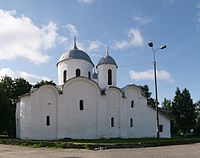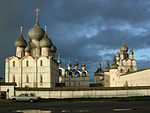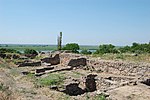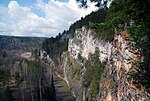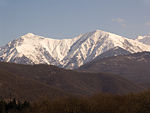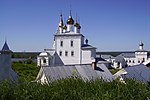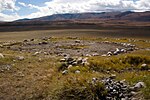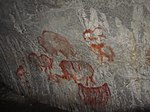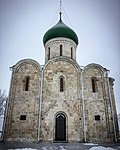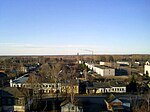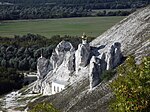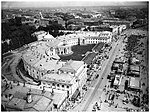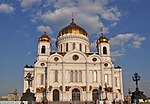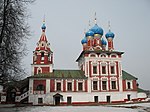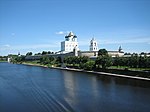World heritage in Russia
The World Heritage in Russia (as of 2019) includes 29 UNESCO World Heritage Sites , including 18 World Cultural Heritage sites and 11 World Natural Heritage sites. These include the Struve Arch , the Curonian Spit and the Daurian Landscapes, three cross-border or transnational World Heritage sites . The Soviet Union , of which Russia is the legal successor , ratified the World Heritage Convention in 1988, and Russia's first three World Heritage sites were added to the World Heritage List in 1990. The last World Heritage site to date was added to the list in 2019.
cards
|
|
|
World heritage sites
The following table lists the UNESCO World Heritage Sites in Russia in chronological order according to the year of their inclusion on the World Heritage List (K - cultural heritage, N - natural heritage, K / N - mixed, R - on the Red List of World Heritage in Danger ).
![]() Map with all coordinates of World Heritage Sites: OSM
Map with all coordinates of World Heritage Sites: OSM
| image | designation | year | Type | Ref. | description |
|---|---|---|---|---|---|
|
Historic center of Saint Petersburg ( location ) |
1990 | K | 540 | The city of Saint Petersburg was the capital of the Russian Empire from the 18th to the 20th century , is an important cultural center throughout Europe and is home to the most important Russian Baltic Sea port. The world heritage includes a. Gatchina , Kronstadt , Lomonossow , Pavlovsk , Peterhof , Pushkin , Shlisselburg . | |
|
Churches of Kizhi Pogost ( Lage ) |
1990 | K | 544 | The 35 m high Transfiguration Church, built in 1714, crowned by 22 onion domes and covered by 30,000 shingles made of aspen wood , is regarded as the boldest preserved wooden structure in Russia, in which no nail was used. Today there are around 60 historical wooden buildings from Karelia and Northern Russia on the island of Kizhi in Lake Onega . | |
| Kremlin and Red Square in Moscow | 1990 | K | 545 | The Moscow Kremlin ( Lage ) is the oldest part of the Russian capital Moscow and its historical center. This is an original in the Middle Ages resulting castle , which from the late 15th century on the model of a citadel was built. The Red Square ( location ) is one of the oldest and, due to its size, its historical significance and the adjacent historical buildings, the most internationally famous square in Moscow and one of the most famous in the world. | |
| Architectural monuments of Novgorod and the surrounding area | 1992 | K | 604 | As one of the oldest cities in Russia, Veliky Novgorod celebrated its 1150th anniversary in September 2009. In the Middle Ages, Novgorod was the capital of an influential trade republic and an important mediator between the Rus and the West before it became part of the centralized Russian Empire . The Novgorod Kremlin and the St. Sophia Cathedral are among the most famous buildings in Novgorod's old town . | |
| Historical and cultural monuments on the Solowetzky Islands on the White Sea | 1992 | K | 632 | In the 13th century , monks settled on the Solovetsky Islands and built a monastery . This was expanded by the Russian tsars in the 18th century into a fortress and a state prison, in which mostly political prisoners were imprisoned for a good two and a half centuries. | |
| Vladimir Cathedral, monasteries and churches of Suzdal and Kideksha | 1992 | K | 633 | As the capital of the Grand Duchy of Vladimir-Suzdal , the city of Vladimir played an important role in Russian history as an important center of culture and power before the Mongol invasion of the Rus, as well as the temporary seat of the Metropolitan of the Russian Orthodox Church . The Moscow grand dukes and tsars held Vladimir in front of Moscow in their titles for several centuries. | |
|
Fortified Monastery of the Holy Trinity and St. Sergius in Sergiev Posad ( location ) |
1993 | K | 657 | The Trinity Monastery of Sergiev Posad was founded around 1340 by Saint Sergius of Radonezh and has been one of the most important religious centers of the Russian Orthodox Church for centuries. | |
| Ascension Church in Kolomenskoe | 1994 | K | 634 | As the first stone church of tent-like shape, the Ascension Church in Kolomenskoye marked a daring break with the Byzantine architectural tradition that had prevailed in Russia until then . | |
| Primeval forests of Komi | 1995 | N | 719 | With an area of 32,800 km², the primeval forests of Komi are the largest contiguous primeval forest area in Europe. | |
|
Lake Baikal ( location ) |
1996 | N | 754 | At 1,642 meters, Lake Baikal is the deepest and, at more than 25 million years, the oldest freshwater lake on earth. | |
| Kamchatka volcano region with the Kluchevskoy Nature Park | 1996 | N | 765 | The Kamchatka Peninsula is 1200 km long and 450 km wide. There are 29 active volcanoes (of more than 160 in total) and many geysers on it . Every year, an average of six of the volcanoes erupt.
The World Heritage Site originally comprised five nature reserves on the peninsula and was expanded in 2001 to include the Klyuchevskoi Nature Park. |
|
|
Golden mountains of the Altai in southern Siberia ( location ) |
1998 | N | 768 | The Altai is a Central Asian high mountain range up to 4506 m high . The mountains are a magnet for mountaineers and excursions due to the beauty of their landscape and flora (nature reserve "Golden Mountains") and the Altaic culture.
The world heritage comprises three separate areas in the mountains. |
|
| Western Caucasus | 1999 | N | 900 | comprises six nature reserves in the western part of the Caucasus Mountains . | |
|
Kazan Kremlin ( location ) |
2000 | K | 980 | The Kazan Kremlin is a historic citadel in Kazan , the capital of the Russian Republic of Tatarstan . It was built after the capture of Kazan by the Russian troops of Ivan IV in 1552 on the ruins of the former residence of the Khan of Kazan. The Kazan Kremlin today combines elements of Christian Orthodox and Muslim architecture. | |
| Ferapontow Monastery | 2000 | K | 982 | The Ferapontov Monastery is a fortified monastery in the Russian Vologda Oblast . It is one of the most significant examples of Russian art of the Middle Ages . It is famous for its wall and ceiling paintings known that in 1502 were created by master Dionisij. | |
| Curonian Spit | 2000 | K | 994 | cross-border with Lithuania | |
|
Central Sichote-Alin Nature Reserve and the Bikin River Valley ( location ) |
2001 | N | 766 | The Sichote-Alin is a high mountain range in the Far East of Russia. Because of the inaccessibility and the oceanic climate, many areas of the mountains are considered to be a varied natural landscape. Bear, wolf and the threatened Siberian tiger roam through primeval beech forests .
The World Heritage site was expanded to include the river valley of the Bikin in 2018, which means that its area has almost quadrupled. |
|
| Uws-Nuur Basin | 2003 | N | 769 | The Uws-Nuur Basin , which lies across borders in Russia and Mongolia, comprises several different ecosystems , such as B. the snow fields in the Turgen Mountains , the lake and steppe areas, the desert of Altan Els . The Uws-Nuur basin represents the border between Siberia and Central Asia. Temperatures there fluctuate between −58 ° C in winter and 47 ° C in summer. Despite these harsh climatic conditions, 173 bird species and 41 mammal species are native to this region. The Uws Nuur is the habitat for many water birds . Rare animal species such as the Mongolian gerbil , snow leopard , wild sheep (Argali) and the Siberian ibex live in the desert and mountain regions around the lake . | |
| Citadel, old town and fortress of Derbent | 2003 | K | 1070 | Derbent is shaped by various cultural influences. | |
| Wrangel Island Nature Reserve | 2004 | N | 1023 | The landscape on Wrangel Island is dominated exclusively by the arctic tundra ; in the high areas there are bare frost debris deserts . Because of the permafrost and the low water content in the soil, tall plants such as trees cannot develop. Therefore lichens , mosses , poppies and ferns predominate. The flora is very rich in species compared to other arctic regions. With 417 plant species, twice as many species live here as on comparable areas and more than on any other Arctic island. Most of these plants that thrive on the mountain slopes are only a few inches tall. | |
| Novodevichy Monastery | 2004 | K | 1097 | The architectural development of the New Maiden Monastery took place between the 16th and 17th centuries. The predominant style of these buildings is the so-called Moscow Baroque. The almost square complex is surrounded by a meter-thick wall, which is interrupted on each side by a gate. The need for protection is taken into account by four corner towers and a further eight towers along the wall. | |
| Yaroslavl old town | 2005 | K | 1170 | Yaroslavl, which celebrated its 1000th anniversary in September 2010, is one of the oldest cities in central Russia . In the Middle Ages, Yaroslavl was the capital of a principality, at the beginning of the 17th century it was the de facto capital of the Russian tsarity for a few months , and before the founding of Saint Petersburg, Yaroslavl was considered the second largest city in Russia. The old town has many churches from the 17th century, the ensemble of the Redeemer-Transfiguration Monastery and a well-preserved road network from the 18th and 19th centuries with predominantly classicist secular buildings . | |
| Struve arch | 2005 | K | 1187 | The transnational world heritage site includes 34 specially marked geodetic measuring points along the meridian arc named after the astronomer Wilhelm von Struve in Estonia, Finland, Latvia, Lithuania, Moldova, Norway, Russia, Sweden, Ukraine and Belarus, which were established in the first half of the 19th century to determine the exact figure of the earth in Northern and Eastern Europe.
In Russia, this includes two measuring points on the Baltic island of Gogland . |
|
| Putorana plateau | 2010 | N | 1234 | The Putorana Mountains , also known as the Putorana Plateau because of its plateau-shaped mountains, are crossed by the largest wild reindeer herd on earth every year . Around 500,000 wild reindeer migrate through the area and spend around five to six months here each year. A specialty is the Putorana snow sheep ( Ovis nivicola borealis ), a geographically isolated subspecies of the snow sheep, which separated from its conspecifics in the main range to the east 15,000 years ago. | |
| Lena Rocks Nature Park | 2012 | N | 1299 | The Lena rocks are a natural stone formation on the banks of the Lena River . The rocks are 150 to 300 meters high and stretch for 80 km. | |
| Historical center and archaeological sites of Bolgar | 2014 | K | 981 | Bolgar was the main castle of the tribal union of the Volga Bulgarians since the 10th century . The archaeological remains on the castle wall in Bolgar suggests for the 10th-12th centuries. In the 19th century, recognized a castle town with extensive long-distance trade connections to the east and west as well as branches of foreign merchants. | |
| Daurian landscapes | 2017 | N | 1448 | cross-border with Mongolia | |
| Assumption Cathedral in the island city of Svyazhsk | 2017 | K | 1525 | About 60 hectares of the entire urban area of the city island of Svyashsk (Ref. 1111 ) were nominated under the designation "Ensemble of former urban buildings of Svyashsk" , but only 3.25 hectares were included in the world heritage. | |
|
Churches of the Pskov School of Architecture ( Lage ) |
2019 | K | 1523 | Pskov is considered the birthplace of the Pskov architecture school . Ten churches or cathedrals in the old city in the far west of Russia are representative of the lasting influence that this type of Russian Orthodox church should have on the following sacred architecture. Characteristic of this architectural style are peculiar cubic elements, domes, portals and bell towers based on the Byzantine and Novgorod tradition, as well as the inclusion in the natural environment through gardens, border walls and fences. This style dates back to the 12th century and peaked in the 15th and 16th centuries. |
Tentative list
The sites that are intended for nomination for inclusion in the World Heritage List are entered in the tentative list .
Current World Heritage candidates
As of 2020, 26 sites are entered in the tentative list of Russia, the last entry was made in 2020. The following table lists the sites in chronological order according to the year of their inclusion in the tentative list.
![]() Map with all coordinates of current World Heritage candidates: OSM
Map with all coordinates of current World Heritage candidates: OSM
| image | designation | year | Type | Ref. | description |
|---|---|---|---|---|---|
| Historical and cultural Dscheirach-Assa reserve | 1996 | K | 569 | 18 settlements with some structures from the Bronze Age in the mountain valleys of the Armhi and Assa rivers near Jirach in Ingushetia | |
|
Historic center of Irkutsk ( location ) |
1998 | K | 1166 | ||
|
The Rostov Kremlin ( location ) |
1998 | K | 1185 | ||
|
Historic Center of Yeniseisk ( Location ) |
2000 | K | 1460 | ||
| Sikachi-Alyan petroglyphs | 2003 | K | 1787 | ||
|
The Commanders Islands (Komandorski Nature Reserve) ( location ) |
2005 | N | 1997 | The archipelago of the Kommandeurinseln comprises 15 islands of different sizes, from 0.5 km 2 to 1667 km 2 , and is particularly worthy of protection due to its biodiversity. | |
| Magadan nature reserve | 2005 | N | 1998 | The proposal comprises four groups of sub-areas in the Magadan Oblast in eastern Siberia . | |
| Krasnoyarsk Columns | 2007 | N | 5113 | The Krasnoyarsk Columns Nature Park south of Krasnoyarsk is known for the eponymous rock formations that are up to 100 m high. | |
| The Wassjuganje swampy landscape | 2007 | N | 5114 | ||
| Ensemble of the Astrakhan Kremlin | 2008 | K | 5368 | ||
| Ilmen Mountains | 2008 | N | 5388 | The Ilmengebirge is a mountain range in the southern Urals and is characterized by a special wealth of various minerals. | |
|
The archaeological site of Tanais ( location ) |
2009 | K | 5422 | The city of Tanias at the mouth of the river of the same name, today's Don , in the Sea of Azov was founded by Greece at the beginning of the 3rd century BC. BC and quickly developed into an important trading center .
|
|
| Bashkir Urals | 2012 | K / N | 5666 | The proposal covers 450 km 2 in the western ascent to the southern Urals in the Republic of Bashkortostan and includes, among other things, the nature reserve and cave system of Shulgan-Tash with Stone Age cave paintings . | |
| Testament of the Kenosero | 2014 | K / N | 5922 | The rural cultural landscape of Kenosero with its wooden monuments emerged from the 12th to the 16th century. The area of the proposal in Arkhangelsk Oblast in northwestern Russia also includes the Kenosero National Park established in 1991 , which has been recognized as a UNESCO Biosphere Reserve since 2004. | |
| Komi Primeval Forests (expansion) | 2014 | N | 5925 | The aim of the expansion is to bring the area of the Komi Primeval Forests (Ref. 719 ) back into harmony with the now enlarged protected areas of the Jugyd Wa National Park and the Pechora-Ilych Nature Reserve . | |
| Western Caucasus (extension) | 2014 | N | 5926 | Planned expansion of the "Western Caucasus" World Heritage Site (Ref. 900 ), includes the 2004 proposal for the "Teberdinski Reserve". | |
| Monument Complex "For the Heroes of the Battle of Stalingrad" on Mamayev Hill | 2014 | K | 5936 | ||
| Oglachty Mountains | 2016 | K / N | 6165 | ||
| Historic center of Gorokhovets | 2017 | K | 6202 | ||
| Treasures of the Pazyryk culture | 2018 | K | 6283 | The proposal includes several groups of kurgan and petroglyphs from the Pazyryk culture in the Altai . | |
| Petroglyphs on Lake Onega and White Sea | 2018 | K | 6358 | ||
| Cave paintings of the Shulgan Tash Cave | 2018 | K | 6309 | The cave paintings of the Shulgan Tash Cave, also known as the Kapowa Cave, were first scientifically described in 1760. There are around 200 cave paintings painted with ocher, more than half of which have only recently been discovered. | |
| Transfiguration Cathedral of the Savior with medieval remains of the city wall of Pereslavl-Zalessky (1152–1157) | 2019 | K | 6427 | ||
|
Vyatskoe village ( location ) |
2019 | K | 6441 | ||
|
Chukchi heritage - Arctic Navy hunters ( location ) |
2019 | K | 6440 | Naukan Settlement, Ekven Cemetery & Settlement, Nunak Historical and Cultural Complex | |
|
Historical and cultural complex of Divnogorye ( location ) |
2020 | K | 6484 |
Former World Heritage candidates
These sites were previously on the tentative list, but were withdrawn or rejected by UNESCO. Sites that are included in other entries on the tentative list or that are part of world heritage sites are not taken into account here.
![]() Map with all coordinates of former World Heritage candidates: OSM
Map with all coordinates of former World Heritage candidates: OSM
| image | designation | year | Type | Ref. | description |
|---|---|---|---|---|---|
|
The sources of the great ob ( location ) |
1995-1996 | N | 768 | The proposal comprised 65,000 km 2 of untouched mountain taiga , glaciers and Lake Teletskoye in the catchment area of the source rivers of the Ob in the Altai in central Siberia . A selection was included in the World Heritage List in 1998 ( Golden Mountains of the Altai , Ref. 768 ). | |
|
Wodlosero National Park ( location ) |
1996-2014 | N | 578 | National Park on Lake Wodlosero | |
| Architectural and historical complex "Home of Count Nikolai Petrovich Sheremetev" | 1996-2016 | K | 571 | Hospital and poor hospital in Moscow donated by Count Nikolai Petrovich Sheremetev | |
|
Valaam Archipelago ( location ) |
1996-2016 | N | 572 | ||
|
Christ the Savior Cathedral ( location ) |
1998-2016 | K | 1168 | ||
| Ensemble of former Svyashsk city buildings | 1998-2017 | K | 1111 | The proposal originally covered an area of 62 hectares. However, only an area of 3.25 hectares with the Assumption Monastery and the Assumption Cathedral was included in the World Heritage List in 2017 (Ref. 1525 ). | |
|
Railway bridge over the Yenisei ( location ) |
2000-2014 | K | 1459 | The Krasnoyarsk Railway Bridge is a railway bridge across the Yenisei near the city of Krasnoyarsk . It was built between 1895 and 1899 for the Trans-Siberian Railway and was the first bridge over the Yenisei. | |
| Dimitri Blood Church | 2001-2016 | K | 1518 | The Dimitri Blood Church in Uglich was built in 1692 in memory of Tsarevich Dmitri Ivanovich , son of Ivan the Terrible , who died in the city in 1591 under unexplained circumstances . | |
| Teberda nature reserve | 2004-2008 | N | 1862 | planned expansion of the Western Kukasus World Heritage Site | |
| Russian Kremlin | 2010-2016 | K | 5517 | included the Astrakhan Kremlin , the Uglich Kremlin and the Pskov Kremlin | |
| Architecture and park ensemble "Ismailowo, the Tsar's country seat" | 2011-2016 | K | 5622 |
Web links
- Russia on the UNESCO World Heritage Center website.
Individual evidence
- ↑ Russia. In: whc.unesco.org. UNESCO World Heritage Center, accessed July 19, 2017 .
- ↑ German names according to the World Heritage List. In: www.unesco.de. German UNESCO Commission, accessed on January 20, 2018 . , if necessary with adaptation of the transcription
- ^ Tentative list of Russia. In: whc.unesco.org. UNESCO World Heritage Center, July 24, 2020, accessed July 24, 2020 .
- ^ Andreas Sternfeldt: River cruises on the Volga: With Enisej, Lena and Amur . Trescher-Verlag , 2007, ISBN 978-3-89794-107-6 (441 pages).
- ^ Former Tentative Sites of Russia. In: World Heritage Site. Retrieved July 19, 2017 .


